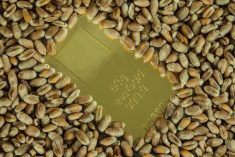I talked to a producer yesterday who has assess the markets and reports of grower intentions and plans to plant more acres of peas and barley on his farm this spring. He hasn’t grown peas for more than a decade.
This may sound crazy, because at dozens of market outlook meetings this winter and in Ag Canada, Stats Canada and USDA surveys, reports and analyses those crops look both poor-returning and unpopular. Most producers have decided those are going to be the losers of the crop game this year.
Read Also

Invigor Gold variety viewed as threat to condiment mustard
Invigor Gold, the canola-quality mustard developed by BASF, is on a collision course with Canada’s condiment mustard industry. It’s difficult to see how the two can co-exist.
And that’s why this guy is swinging acres into unpopular crops. It’s a contrarian bet against the vast herds of farmers who seem to be getting ready to stampede into oilseeds and special crops like lentils, chickpeas and mustard. He’s betting that whatever looks good right now is going to encourage farmers to go out and plant it in the spring, thereby crushing the crop. Whatever looks really poor right now, like peas, might be greatly shunned and leave the few guys who grow much – like him – in a much better position than present conditions would suggest.
It’s not such a crazy thing he’s doing. American farmers, looking at better soybean returns projected now compared to bad-looking corn, are likely to up their acreage of soybeans this spring. This guy I was talking to, at a farm meeting in Unity, Sask., has relatives down in the U.S. Midwest and they’re all planning to increase soybean acres this spring. USDA has projected about a four million acre increase of soybeans this spring and a corresponding decline of corn and wheat acres.
That dynamic had one analyst at GrainWorld in Winnipeg on Monday predicting that by harvest time the strong crops would be the grains and oilseeds the weaklings. Recently North Dakota broker and analyst Mike Krueger pointed out that U.S. farmers have recently shown a willingness to not just make small acreage moves like this year’s projected four million acre switch, but also giant switches right at harvest time into whatever looks good. A few years ago that was corn, which rocketed up by 15 million acres and stunned the world. He thinks there’s a good chance American farmers do the same with soybeans this spring.
Recently canola basis levels have been fantastic on the prairies. That’s a nice relief from the post harvest months when 40-under was common. It’s getting rid of a lot of crop and that’s a good thing, considering the close to three million tonnes that had been forecast as the 09-10 carryout. But is that going to be the trigger that causes prairie farmers to boost canola acreage? Already, because of positive return outlooks, prairie farmers have been telling surveyors that they plan to boost canola acreage by 600,000 this spring. That was before basis rose to near-zero in many areas. Will that recent warm feeling about canola push more guys into bigger acreages? That could be deadly for canola prices if stocks become even more burdensome than last year.
The same goes for special crops, which right now appear to be the best return prospects among all the crops of Western Canada. Stocks are forecast to slide for pretty much everything but peas and most edible beans, so their price outlook is looking better than for the big crops. But, as Marlene Boersch pointed out at GrainWorld, these crops sell into micromarkets and have inelastic demand. That means if you stretch production too much, you snap prices and they break. Right now red lentils, pinto beans, chick peas and mustard among others seem like the best bet for a profitable crop this spring. Is that going to cause farmers to flood the market with new production and destroy those prospects, as has repeatedly happened in special crops?
That’s why this farmer I was speaking with in Unity is favouring the unloved pea. If everyone’s going to look negatively at it, maybe it’s the sleeper, the dark horse of 2009-10. It may sound rash or unwise if you’re a conventional thinker, but if you’re a contrarian and a gut-based person, it wouldn’t sound so crazy. The future’s impossible to predict, but various individuals have prospered by betting against the crowd, and whenever you’re betting against the crowd you seem a little weird.
Right now no one, especially farmers, knows what the North American farmer is going to plant this spring. It’s a standoff and a staredown between farmers, prices, and the planting plans of other farmers. It’s a very complex and financially crucial time, while millions of farmers en masse make up their minds on which crops to pull the trigger on. And it’s a confrontation that will only explode in action when the seeders roll, and the winners will only begin to be seen once the smoke clears over the summer and we see who really planted what.















